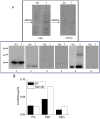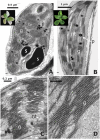Role of plastid transglutaminase in LHCII polyamination and thylakoid electron and proton flow
- PMID: 22870182
- PMCID: PMC3411467
- DOI: 10.1371/journal.pone.0041979
Role of plastid transglutaminase in LHCII polyamination and thylakoid electron and proton flow
Abstract
Transglutaminases function as biological glues in animal cells, plant cells and microbes. In energy producing organelles such as chloroplasts the presence of transglutaminases was recently confirmed. Furthermore, a plastidial transglutaminase has been cloned from maize and the first plants overexpressing tgz are available (Nicotiana tabacum TGZ OE). Our hypothesis is that the overexpression of plastidal transglutaminase will alter photosynthesis via increased polyamination of the antenna of photosystem II. We have used standard analytical tools to separate the antenna from photosystem II in wild type and modified plants, 6 specific antibodies against LHCbs to confirm their presence and sensitive HPLC method to quantify the polyamination level of these proteins. We report that bound spermidine and spermine were significantly increased (∼80%) in overexpressors. Moreover, we used recent advances in in vivo probing to study simultaneously the proton and electron circuit of thylakoids. Under physiological conditions overexpressors show a 3-fold higher sensitivity of the antenna down regulation loop (qE) to the elicitor (luminal protons) which is estimated as the ΔpH component of thylakoidal proton motive force. In addition, photosystem (hyper-PSIIα) with an exceptionally high antenna (large absorption cross section), accumulate in transglutaminase over expressers doubling the rate constant of light energy utilization (Kα) and promoting thylakoid membrane stacking. Polyamination of antenna proteins is a previously unrecognized mechanism for the modulation of the size (antenna absorption cross section) and sensitivity of photosystem II to down regulation. Future research will reveal which peptides and which residues of the antenna are responsible for such effects.
Conflict of interest statement
Figures












Similar articles
-
Remodeling of tobacco thylakoids by over-expression of maize plastidial transglutaminase.Biochim Biophys Acta. 2009 Oct;1787(10):1215-22. doi: 10.1016/j.bbabio.2009.05.014. Epub 2009 Jun 2. Biochim Biophys Acta. 2009. PMID: 19497298
-
Characterisation of Zea mays L. plastidial transglutaminase: interactions with thylakoid membrane proteins.Plant Biol (Stuttg). 2010 Sep 1;12(5):708-16. doi: 10.1111/j.1438-8677.2009.00280.x. Plant Biol (Stuttg). 2010. PMID: 20701693
-
Modulation of energy-dependent quenching of excitons in antennae of higher plants.Proc Natl Acad Sci U S A. 2004 Apr 13;101(15):5530-5. doi: 10.1073/pnas.0401269101. Epub 2004 Apr 2. Proc Natl Acad Sci U S A. 2004. PMID: 15064404 Free PMC article.
-
Determining the limitations and regulation of photosynthetic energy transduction in leaves.Plant Cell Environ. 2007 Sep;30(9):1107-25. doi: 10.1111/j.1365-3040.2007.01680.x. Plant Cell Environ. 2007. PMID: 17661750 Review.
-
Regulatory network of proton motive force: contribution of cyclic electron transport around photosystem I.Photosynth Res. 2016 Sep;129(3):253-60. doi: 10.1007/s11120-016-0227-0. Epub 2016 Feb 8. Photosynth Res. 2016. PMID: 26858094 Review.
Cited by
-
Silencing S-Adenosyl-L-Methionine Decarboxylase (SAMDC) in Nicotiana tabacum Points at a Polyamine-Dependent Trade-Off between Growth and Tolerance Responses.Front Plant Sci. 2016 Mar 31;7:379. doi: 10.3389/fpls.2016.00379. eCollection 2016. Front Plant Sci. 2016. PMID: 27064210 Free PMC article.
-
Plant Transglutaminases: New Insights in Biochemistry, Genetics, and Physiology.Cells. 2022 May 3;11(9):1529. doi: 10.3390/cells11091529. Cells. 2022. PMID: 35563835 Free PMC article. Review.
-
Dark-induced senescence of barley leaves involves activation of plastid transglutaminases.Amino Acids. 2015 Apr;47(4):825-38. doi: 10.1007/s00726-014-1912-y. Epub 2015 Jan 13. Amino Acids. 2015. PMID: 25583605 Free PMC article.
-
Light-independent pathway of STN7 kinase activation under low temperature stress in runner bean (Phaseolus coccineus L.).BMC Plant Biol. 2024 Jun 7;24(1):513. doi: 10.1186/s12870-024-05169-3. BMC Plant Biol. 2024. PMID: 38849759 Free PMC article.
-
Senescence and programmed cell death in plants: polyamine action mediated by transglutaminase.Front Plant Sci. 2014 Apr 7;5:120. doi: 10.3389/fpls.2014.00120. eCollection 2014. Front Plant Sci. 2014. PMID: 24778637 Free PMC article. Review.
References
-
- Kramer DM, Cruz JA, Kanazawa A (2003) Balancing the central roles of the thylakoid proton gradient. Trends Plant Sci 8: 27–32. - PubMed
-
- Pascal AA, Liu Z, Broess K, van Oort B, van Amerongen H, et al. (2005) Molecular basis of photoprotection and control of photosynthetic light-harvesting. Nature 436: 134–137. - PubMed

